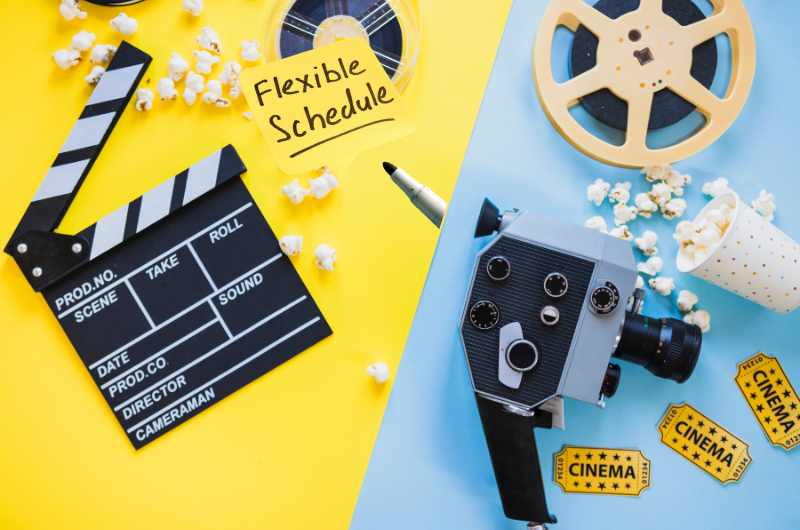Planning an entertainment schedule for an event, whether it’s a party, wedding, or corporate social occasion, can be an overwhelming undertaking. With so many moving parts and factors to consider, it’s critical to painstakingly plan out the schedule to ensure that everything runs smoothly and that guests are engaged throughout the event. From settling on the types of entertainment to booking performers and organizing logistics, making a thoroughly examined entertainment schedule is essential to the success of any event.
1. Begin by posting the key events or activities you need to remember for your entertainment schedule, for example, unrecorded music, comedy shows, or interactive games.
When it comes to creating an entertainment schedule, it’s critical to start by listing all the key events or activities that you want to include in your setup. Whether you’re organizing a music festival, a corporate event, or a community fair, having a clear idea of the types of entertainment you want to offer will help you create a cohesive and engaging schedule for your participants.
Tailoring Entertainment to Your Audience
Consider what your target audience enjoys and what will keep them engaged throughout the duration of your event. Are they music lovers who would appreciate live bands and DJs? Or are they more into comedy shows and theatrical performances? Perhaps they would enjoy interactive games, workshops, or art installations. By understanding the preferences and interests of your audience, you can tailor your entertainment schedule to cater to their needs and create a memorable experience for all involved.
Logistics and Timing Considerations will help in making your entertainment schedule
Once you have a list of the key events or activities you want to include, think about the logistics of each one. How long will each performance or activity last? What are the technical requirements, such as sound equipment or lighting? Will there be any breaks or intervals between acts? Thoroughly considering these details will help you create a smooth and organized schedule that flows seamlessly from one event to the next.
Venue Layout and Design
Remember to also consider the layout and design of your venue. Will there be multiple stages or areas for different types of entertainment? How will participants navigate the various performances or activities? Keeping the flow and accessibility of your entertainment schedule in mind will help you avoid congestion and confusion among your guests.
Highlighting Key Performances in your entertainment schedule
As well as listing the key events or activities you want to include in your entertainment schedule, consider any special or featured performances that will be the highlights of your event. Perhaps you have a headline act or a special guest appearance that you want to showcase. By highlighting these key performances in your schedule, you can build anticipation and excitement among your participants.
Flexibility and Adaptability
Finally, be sure to leave some flexibility in your entertainment schedule for unexpected situations or changes. Perhaps a performer runs overtime, or technical difficulties arise. Having a backup plan or being able to adjust the schedule on the fly will help you stay on track and ensure a successful event.
2. Consider the preferences and interests of your audience while settling on the timing and duration of every event.
When creating an entertainment schedule, it’s important to consider the preferences and interests of your audience. You want to keep them engaged and entertained throughout the event, so understanding what they enjoy and how long they will participate is essential.
Demographics and Interests
First and foremost, think about the demographics of your audience. Are they younger or older? Do they enjoy specific hobbies or interests that you can cater to? Understanding who will attend your event will help you tailor the entertainment schedule to their tastes. For instance, if you are hosting an event for families with young children, you may want to include activities that are kid-friendly and engage the entire family.
Timing and Engagement
Additionally, consider the timing of each event in the schedule. Are there certain times of the day when your audience is more likely to be engaged? For example, if you are hosting a conference for professionals, it might be best to schedule more interactive and engaging activities in the morning when participants are fresh and alert. Conversely, if you are hosting a social gathering in the evening, you may want to plan for more relaxed and laid-back entertainment to unwind.
Event Duration
The duration of each event is also an important factor to consider. You want to ensure that each activity or performance is long enough to be engaging but not so lengthy that it loses the interest of your audience. Keep in mind that attention spans can vary depending on the age and preferences of your audience. For instance, children may have shorter attention spans and may require shorter, more interactive activities, while adults may be able to endure longer performances or presentations.
Variety in Entertainment
It’s also a good idea to mix up the types of entertainment throughout the schedule to keep things interesting. Consider including various activities such as live performances, interactive games, workshops, and networking opportunities. This will cater to different interests within your audience and ensure that there is something for everyone to enjoy.
Flexibility in Scheduling
Ultimately, be flexible with your entertainment schedule. Sometimes unexpected challenges or delays can arise, so it’s important to have a backup plan in case things don’t go as expected. By being prepared and adaptable, you can ensure that your audience remains engaged and entertained throughout the event.
3. Create a balanced entertainment schedule that incorporates a mix of various entertainment options to cater to a different crowd.
When planning an entertainment schedule for an event or venue, it is crucial to consider the diverse preferences of your audience. To ensure that everyone has a good time, it’s essential to create a balanced schedule that includes a mix of different entertainment options.
Audience Demographics
First and foremost, consider the demographics of your audience. Are they predominantly young adults, families, or seniors? Understanding the age range and interests of your participants will help you tailor the entertainment schedule to cater to their specific preferences. For example, if you’re hosting an event for families, you may want to include activities and entertainment that are suitable for children, such as storytelling or a magic show.
Cultural Background and Interests
In addition to considering the age range of your audience, it’s also important to think about their cultural background and interests. If you’re hosting an event that attracts a diverse crowd, consider including entertainment options that reflect various cultures and traditions. This could include live music performances from different genres, dance performances, or cultural exhibits.
Include Variety of Entertainment Offerings in your entertainment schedule
Furthermore, when creating a balanced entertainment schedule, it’s important to mix up the types of entertainment offerings. Avoid relying solely on one type of entertainment, such as live music or comedy acts. Instead, diversify your schedule by including various options that cater to different preferences. This could include interactive games, workshops, art installations, or outdoor activities.
Consider Timing and Flow of Events when creating a balanced entertainment schedule
Another important aspect to consider when creating a balanced entertainment schedule is the timing of the events. Be mindful of the flow of the event and schedule entertainment options at strategic times to keep the audience engaged and excited. For example, if you’re hosting a day-long event, consider starting off with high-energy entertainment options to kick things off, and then gradually transition to more relaxed and laid-back activities as the day progresses.
Flexibility in the Schedule
Finally, be sure to leave some room for flexibility in your schedule. Unexpected things can happen during an event, and it’s important to be able to adapt and make changes on the fly. Whether it’s extending the duration of a popular act, adding an impromptu performance, or rearranging the schedule based on feedback from the audience, being flexible will ensure that your entertainment schedule is dynamic and engaging.
Conclusion
In conclusion, creating a balanced entertainment schedule that caters to a diverse audience involves considering the demographics, cultural background, and interests of your audience, mixing up the types of entertainment offerings, carefully timing the events, and leaving room for flexibility. By taking these factors into account, you can create an entertainment schedule that is inclusive, engaging, and enjoyable for all participants.

